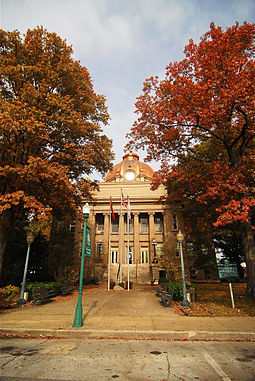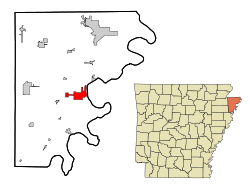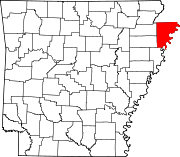- Osceola, Arkansas
-
Osceola, Arkansas — City — Location in Mississippi County and the state of Arkansas Coordinates: 35°42′8″N 89°58′33″W / 35.70222°N 89.97583°WCoordinates: 35°42′8″N 89°58′33″W / 35.70222°N 89.97583°W Country United States State Arkansas County Mississippi Area – Total 7.8 sq mi (20.2 km2) – Land 7.8 sq mi (20.2 km2) – Water 0 sq mi (0 km2) Elevation 246 ft (75 m) Population (2010) – Total 7,757 – Density 1,137.8/sq mi (439.4/km2) Time zone Central (CST) (UTC-6) – Summer (DST) CDT (UTC-5) ZIP code 72370 Area code(s) 870 FIPS code 05-52580 GNIS feature ID 0077931 Osceola is a city in and one of the two county seats of Mississippi County, Arkansas, United States.[1] The population was 7,757 at the 2010 census.
Contents
Geography
Osceola is located at 35°42′8″N 89°58′33″W / 35.70222°N 89.97583°W (35.702276, -89.975807)[2].
According to the United States Census Bureau, the city has a total area of 7.8 square miles (20 km2), all land.
Osceola was the original county seat of Mississippi County and remains one of two county seats, after Blytheville was named a dual county seat in 1901. Osceola features a 1912 Neo-Classical courthouse with a copper roofed dome. The courthouse is bordered by the Hale Avenue Historic District and other structures on the National Historic Register of Historic Places. Visitors will also find the Mississippi County Historical Center located in a 1904 building that once housed a dry goods store.
Osceola is famous for its role in the development of blues music, and many famous blues musicians either came from Osceola or performed there. To celebrate this heritage, Main Street Osceola has been hosting the Osceola Heritage Festival since 1998.
Demographics
As of the census[3] of 2000, there were 8,875 people, 3,183 households, and 2,314 families residing in the city. The population density was 1,135.9 people per square mile (438.8/km²). There were 3,551 housing units at an average density of 454.5 per square mile (175.6/km²). The racial makeup of the city was 47.39% White, 51.03% Black or African American, 0.10% Native American, 0.25% Asian, 0.41% from other races, and 0.82% from two or more races. 1.34% of the population were Hispanic or Latino of any race.
There were 3,183 households out of which 38.5% had children under the age of 18 living with them, 43.3% were married couples living together, 25.2% had a female householder with no husband present, and 27.3% were non-families. 24.4% of all households were made up of individuals and 10.3% had someone living alone who was 65 years of age or older. The average household size was 2.70 and the average family size was 3.20.
In the city the population was spread out with 32.2% under the age of 18, 11.0% from 18 to 24, 26.4% from 25 to 44, 19.3% from 45 to 64, and 11.1% who were 65 years of age or older. The median age was 30 years. For every 100 females there were 90.2 males. For every 100 females age 18 and over, there were 82.9 males.
The median income for a household in the city was $23,163, and the median income for a family was $26,588. Males had a median income of $27,526 versus $18,788 for females. The per capita income for the city was $12,406. About 26.0% of families and 29.5% of the population were below the poverty line, including 41.0% of those under age 18 and 25.7% of those age 65 or over.
Climate
Osceola has a humid subtropical climate (Köppen climate classification Cfa).
Climate data for Osceola Month Jan Feb Mar Apr May Jun Jul Aug Sep Oct Nov Dec Year Average high °F (°C) 45
(7)51
(11)60
(16)71
(22)80
(27)89
(32)92
(33)90
(32)84
(29)74
(23)60
(16)49
(9)70 Average low °F (°C) 28
(−2)32
(0)41
(5)49
(9)59
(15)67
(19)71
(22)68
(20)60
(16)48
(9)40
(4)31
(−1)50 Precipitation inches (mm) 3.69
(93.7)3.78
(96)4.87
(123.7)4.90
(124.5)5.57
(141.5)4.06
(103.1)3.56
(90.4)2.67
(67.8)3.65
(92.7)3.38
(85.9)4.84
(122.9)4.55
(115.6)49.52
(1,257.8)Source: [4] Notable natives & residents
- Bill Alexander, U.S. Representative from First Congressional District, 1969–1993
- David Barrett, New York Jets cornerback
- Maurice Carthon, former NFL and USFL player and NFL assistant coach
- Ran Carthon, running back with Indianapolis Colts
- Dale Evans, wife of Roy Rogers, TV and movie Star
- Calvin Frazier, blues guitarist, an associate of Robert Johnson
- Buddy Jewell, the first Nashville Star winner
- Cortez Kennedy, former NFL defensive lineman
- Albert King, blues legend
- Gaylon Nickerson, former NBA player
- Bill Ramsey, played baseball for the Boston Braves
- Billy Lee Riley, Sun Records artist, Rockabilly star
- Son Seals, blues guitarist
- Fice Musaveni, American Producer/Musician
- Jimmy Thomas, blues recording artist, lead singer for Ike Turner
- James Williams, former NFL player
- Kemmons Wilson, Holiday Inn founder
- Reggie Young, guitar legend recording artist, Elvis, Nashville
References
- ^ "Find a County". National Association of Counties. http://www.naco.org/Counties/Pages/FindACounty.aspx. Retrieved 2011-06-07.
- ^ "US Gazetteer files: 2010, 2000, and 1990". United States Census Bureau. 2011-02-12. http://www.census.gov/geo/www/gazetteer/gazette.html. Retrieved 2011-04-23.
- ^ "American FactFinder". United States Census Bureau. http://factfinder.census.gov. Retrieved 2008-01-31.
- ^ "Average weather for Osceola, Arkansas". Weather.com. http://www.weather.com/weather/climatology/monthly/72370?x=0&y=0. Retrieved December 21, 2008.
External links
- History of Osceola's Jewish community (from the Institute of Southern Jewish Life)
Municipalities and communities of Mississippi County, Arkansas Cities Blytheville | Gosnell | Joiner | Keiser | Leachville | Manila | Osceola
Towns Unincorporated
communitiesArkmo‡ | Athelstan | Creamery Package | Denwood | Dimple | Driver | Floodway | Frenchmans Bayou | Poplar Corner | Turner | West Ridge
Footnotes ‡This populated place also has portions in an adjacent county or counties
Categories:- Populated places in Mississippi County, Arkansas
- Cities in Arkansas
- Arkansas populated places on the Mississippi River
- Populated places in Arkansas with African American majority populations
- County seats in Arkansas
Wikimedia Foundation. 2010.



